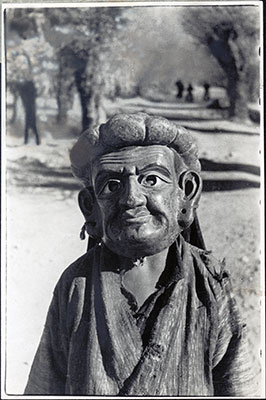
1998.131.261 (Print black & white)


1998.131.261 (Print black & white)

Frederick Spencer Chapman
Frederick Spencer Chapman
December 1st 1936
Lhasa > Dekyi Lingka
1998.131.261
121 x 81 mm
Print gelatin silver
Donated 1994
Faith Spencer Chapman
British Diplomatic Mission to Lhasa 1936-37
Frederick Spencer Chapman
BB.12 [view film roll]
SC.T.2.261
Notes on print/mount - A thin piece of tracing paper has been stuck to the back of the print and folded over the front. This would have been used to transfer crop marks and other instructions from back to front although it has not been used in this case. A number of annotations have been made on the back of the print in pencil. These include the phrase 'Facsimile' and 'Mummers papier-mache mask'. Other numbers of significance include '30a' in the top left hand corner and 'B-B-12' written across the centre. This seems to relate to the numbering system adopted by Chapman for images taken during the Mission to Lhasa in 1936-7 under Sir Basil Gould [MS 15/2/2005]
Manual Catalogues - Caption in Chapman's hand-written list of negatives made whilst on the Mission to Lhasa, 1936-7 [See PRM Manuscripts Collection]: 'close-up of green mask'; PRM Manuscripts Collection: ‘List of Tibetan Prints and Negatives’ - Book 3: ‘30/4 - Mummies masks’ [MS 16/03/2006]
Other Information - Related Images: Images prefixed with 'BB' comprise a group of negatives containing images of street scenes, the new depon at Gyantse, 2 monks with long trumpets, mummers, Pendong, Kalon lama, the head of Kundeling, ‘disease chasing ceremony’ and Chinese statues in Kundeling monastery. They seem to have been taken between the end of November and December 10th 1936 [MS 16/03/2006]
Other Information - Description: Chapman describes in the official Diary of the British Mission to Lhasa for the day of December 1st 1936 how this troupe of Lhasa mummers visited the Dekyi Lingka. He wrote in the entry for this date: "Some mummers came and danced for our entertainment. These are local performers as opposed to the more accomplished Khamba dancers and acrobats who tour the countryside professionally". See 1998.131.555/556/557 for images of the Khampa troupe. Chapman went on to describe the Lhasa mummers more fully in his published account of the Mission, Lhasa the Holy City [London: Chatto & Windus, 1938; reprint, London: Readers Union Ltd., 1940]. He wrote: "Another troupe that visited us was the Lhasa mummers. These were local artisans and farm labourers who occasionally spend an afternoon in this manner. There were eight men in all. One pair wore extremely skilfully made masks of bright green papier mache; another couple wore skeleton masks, while the third held a long striped stick and wore a mask with a vacant melancholy expression. The other three comprised the band - two with large drums, each supported by a handle, while the third played cymbals. // Various dances were performed in which the actors stepped solemnly round each other, made gestures with their arms and bowed, as they endeavoured to act traditional stories which seemed to be well known to the Tibetans. // Dancing, except when performed by the monks, is considered a very low caste occupation, and all the performers, both Khampas and mummers, seemed to be very poor" [1940, p.273] [MS 26/3/2005]
Other Information - Cultural Background: Masks represent characters from religious plays - often depicting the defeat of Hinduism by Buddhism. This mask represents an Indian Saddhu. This figure may occur frequently in Tibetan drama [TS 31/1/2005]
Other Information - Cultural Background: Although Chapman refers to these masks as having been made of papier mache, they are more likely to have been carved out of hardwood or made of cloth layered in a clay mould hardened with glue. They would not usually be made of paper because paper was very rare and expensive. These appear to have been made of carved wood [TS 31/1/2005]
For Citation use:
The Tibet Album.
"Lhasa mummer"
05 Dec. 2006. The Pitt Rivers Museum.
<http://tibet.prm.ox.ac.uk/photo_1998.131.261.html>.
For more information about photographic usage or to order prints, please visit the The Pitt Rivers Museum.
© The Pitt Rivers Museum